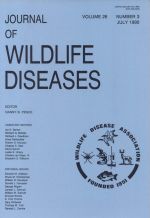We examined the effects of lead ingestion on in vitro and in vivo indices of immune function in mallards (Anas platyrhynchos). Twenty-four mallard drakes were randomly divided into three groups (I, II, III), then assigned to treatment or control subgroups (n = 4). On day 0, all treatment birds were dosed orally with one number 4 lead shot (x̄ = 0.2 g). We challenged all individuals in each group with washed sheep red blood cells (SRBC) injected intraperitoneally on days 0 (Group I), 7 (Group II) or 14 (Group III), and collected blood for analyses 7 and 8 days after SRBC challenge. We measured and compared blood lead concentrations, in vitro lymphocyte transformation responses to phytohemagglutinin A and lipopolysaccharide, and hemagglutination titers to SRBC. Mean blood lead concentrations were elevated (P ≤ 0.04) in treatment birds at each sampling period. Large individual variability in lymphocyte stimulation responses precluded further analysis of those data. Hemagglutination titers to SRBC were lower (P < 0.0001) in lead-poisoned ducks than in controls, suggesting that ingested lead may have immunosuppressive effects on mallards.
How to translate text using browser tools
1 July 1990
EFFECTS OF INGESTED LEAD ON ANTIBODY PRODUCTION IN MALLARDS (ANAS PLATYRHYNCHOS)
Kimberly A. Trust,
Michael W. Miller,
James K. Ringelman,
Ian M. Orme

Journal of Wildlife Diseases
Vol. 26 • No. 3
July 1990
Vol. 26 • No. 3
July 1990
Anas platyrhynchos
experimental study
hemagglutination
immunosuppression
intoxication
lead
lymphocyte transformation




